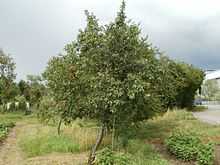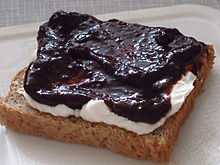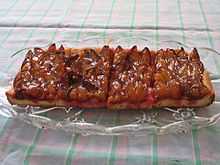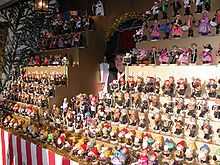Zwetschge
| Zwetschge | |
|---|---|
 | |
| Zwetschge tree in fruit | |
| Scientific classification | |
| Kingdom: | Plantae |
| (unranked): | Angiosperms |
| (unranked): | Eudicots |
| (unranked): | Rosids |
| Order: | Rosales |
| Family: | Rosaceae |
| Genus: | Prunus |
| Subgenus: | Prunus |
| Section: | Prunus |
| Species: | P. domestica |
| Subspecies: | P. domestica subsp. domestica |
| Trinomial name | |
| Prunus domestica subsp. domestica (L.) (Borkh.) C.K.Schneid. | |
| Synonyms | |
| |
The zwetschge (/ˈtsvɛtʃɡə/) (Prunus domestica subsp. domestica) is a fruit-bearing tree, or its fruit. It is a subspecies of the plum Prunus domestica.[1] The freestone fruit is similar to, but distinct from, the clingstone damson (Prunus domestica subsp. insititia)[2] and is especially popular in Central Europe.




Etymology
The word zwetschge, plural zwetschgen, is from the German. Variants of the word include: quetsch(e) (Alsace, Luxembourg, and regionally in Germany); zwetschke (regionally in Austria); and zwetsche (regionally in Germany).[3] These names, like damson, are thought ultimately to derive from postulated non-standard Latin *davascena, meaning "of Damascus". Czech švestka is from the German.[4]
Description
The zwetschge tree is often found in streuobstwiesen. It grows to 6–10 m in height; older trees have spreading branches. The bark is brownish. The leaf is simple, 4–10 cm long, alternate, petiolate, crenulate, and elliptic. The blossom appears in April and May in the Northern Hemisphere, before or with foliation, and is white, greenish-white, or yellowish-green on two or three downy pedicels. The fruit is a freestone drupe. It is less round than other plums, its ends are more pointed and the groove is less pronounced.[5]
Uses
The red-brown wood is used in fine cabinetry.
The fruit, which ripens in August and September in the Northern Hemisphere, is a popular seasonal table fruit.
Zwetschgen hold their form well at oven temperatures and are much used in baking,[6] for example in tarts such as quetschentaart and zwetschgenkuchen. Zwetschgen are the sole ingredient in the traditional powidl jam of Austria and the Czech Republic, and the main ingredient in schmootsch, a similar but spiced jam from Silesia. Fermented zwetschgen are distilled to make eaux de vie: zwetschgenwasser or zwetsch (in Austria, Germany, and Switzerland), zwetschgeler (in South Tyrol, Italy), and quetsch (in Alsace, France). Carlsbad plums are a candied zwetschgen confection called after Carlsbad (now Karlovy Vary) in the Czech Republic. Szilvás gombóc and zwetschkenknödel are potato dumplings with a zwetschgen filling in Hungary and Austria respectively, served as a sweet main course or as a dessert. At Christmas markets in Germany, for example the Christkindlesmarkt in Nuremberg, a zwetschgenmännla ("little zwetschge man") or zwetschgenweibla ("little zwetschge woman"), with a walnut head, a body of dried figs, and limbs of dried zwetschgen, is a popular treat.
Varieties
More than a hundred varieties of zwetschge are grown in Central Europe. Examples include Cacaks Beste, Elena, Hauszwetschge, and Ortenauer.
-
Cacaks Beste
-
Elena
-
Hauszwetschge
-
Ortenauer
References
- ↑ European Environment Agency EUNIS, Prunus domestica ssp. domestica L., Common names and synonyms: http://eunis.eea.europa.eu/species/179701
- ↑ Sorting Prunus Names: http://www.plantnames.unimelb.edu.au/Sorting/Prunus_Pt2.html
- ↑ Wiktionary: http://en.wiktionary.org/wiki/Zwetsche
- ↑ Grimm, Deutsches Wörterbuch (German): http://woerterbuchnetz.de/DWB/?sigle=DWB&mode=Vernetzung&lemid=GZ13174
- ↑ Baumkunde.de: Zwetschge (Prunus domestica subsp. domestica) (German): http://www.baumkunde.de/Prunus_domestica_subsp_domestica/
- ↑ Plum or zwetschge? (German): http://www.test.de/Leserfrage-Pflaume-oder-Zwetschge-4127383-0/
Some information in this article is from the corresponding article on German Wikipedia



